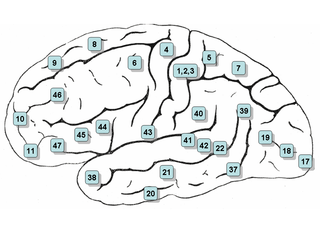The following outline is provided as an overview and topical guide to linguistics:

Colorless green ideas sleep furiously is a sentence composed by Noam Chomsky in his 1957 book Syntactic Structures as an example of a sentence that is grammatically well-formed, but semantically nonsensical. The sentence was originally used in his 1955 thesis The Logical Structure of Linguistic Theory and in his 1956 paper "Three Models for the Description of Language". There is no obvious understandable meaning that can be derived from it, which demonstrates the distinction between syntax and semantics, and the idea that syntactic well-formedness does not equivalate semantic well-formedness. As an example of a category mistake, it was used to show the inadequacy of certain probabilistic models of grammar, and the need for more structured models.
In linguistics, transformational grammar (TG) or transformational-generative grammar (TGG) is part of the theory of generative grammar, especially of natural languages. It considers grammar to be a system of rules that generate exactly those combinations of words that form grammatical sentences in a given language and involves the use of defined operations to produce new sentences from existing ones. The method is commonly associated with American linguist Noam Chomsky.

Neurolinguistics is the study of neural mechanisms in the human brain that controls the comprehension, production, and acquisition of language. As an interdisciplinary field, neurolinguistics draws methods and theories from fields such as neuroscience, linguistics, cognitive science, communication disorders and neuropsychology. Researchers are drawn to the field from a variety of backgrounds, bringing along a variety of experimental techniques as well as widely varying theoretical perspectives. Much work in neurolinguistics is informed by models in psycholinguistics and theoretical linguistics, and is focused on investigating how the brain can implement the processes that theoretical and psycholinguistics propose are necessary in producing and comprehending language. Neurolinguists study the physiological mechanisms by which the brain processes information related to language, and evaluate linguistic and psycholinguistic theories, using aphasiology, brain imaging, electrophysiology, and computer modeling.
In generative grammar, a theta role or θ-role is the formal device for representing syntactic argument structure—the number and type of noun phrases—required syntactically by a particular verb. For example, the verb put requires three arguments.
Case grammar is a system of linguistic analysis, focusing on the link between the valence, or number of subjects, objects, etc., of a verb and the grammatical context it requires. The system was created by the American linguist Charles J. Fillmore in the context of Transformational Grammar (1968). This theory analyzes the surface syntactic structure of sentences by studying the combination of deep cases which are required by a specific verb. For instance, the verb "give" in English requires an Agent (A) and Object (O), and a Beneficiary (B); e.g. "Jones (A) gave money (O) to the school (B).
In linguistics, an argument is an expression that helps complete the meaning of a predicate, the latter referring in this context to a main verb and its auxiliaries. In this regard, the complement is a closely related concept. Most predicates take one, two, or three arguments. A predicate and its arguments form a predicate-argument structure. The discussion of predicates and arguments is associated most with (content) verbs and noun phrases (NPs), although other syntactic categories can also be construed as predicates and as arguments. Arguments must be distinguished from adjuncts. While a predicate needs its arguments to complete its meaning, the adjuncts that appear with a predicate are optional; they are not necessary to complete the meaning of the predicate. Most theories of syntax and semantics acknowledge arguments and adjuncts, although the terminology varies, and the distinction is generally believed to exist in all languages. Dependency grammars sometimes call arguments actants, following Lucien Tesnière (1959).
The term linguistic performance was used by Noam Chomsky in 1960 to describe "the actual use of language in concrete situations". It is used to describe both the production, sometimes called parole, as well as the comprehension of language. Performance is defined in opposition to "competence"; the latter describes the mental knowledge that a speaker or listener has of language.
Sentence processing takes place whenever a reader or listener processes a language utterance, either in isolation or in the context of a conversation or a text. Many studies of the human language comprehension process have focused on reading of single utterances (sentences) without context. Extensive research has shown that language comprehension is affected by context preceding a given utterance as well as many other factors.
In certain theories of linguistics, thematic relations, also known as semantic roles, are the various roles that a noun phrase may play with respect to the action or state described by a governing verb, commonly the sentence's main verb. For example, in the sentence "Susan ate an apple", Susan is the doer of the eating, so she is an agent; an apple is the item that is eaten, so it is a patient.
In linguistics, grammaticality is determined by the conformity to language usage as derived by the grammar of a particular speech variety. The notion of grammaticality rose alongside the theory of generative grammar, the goal of which is to formulate rules that define well-formed, grammatical, sentences. These rules of grammaticality also provide explanations of ill-formed, ungrammatical sentences.
The P600 is an event-related potential (ERP) component, or peak in electrical brain activity measured by electroencephalography (EEG). It is a language-relevant ERP component and is thought to be elicited by hearing or reading grammatical errors and other syntactic anomalies. Therefore, it is a common topic of study in neurolinguistic experiments investigating sentence processing in the human brain.
The bǎ construction is a grammatical construction in the Chinese language. In a bǎ construction, the object of a verb is placed after the function word 把; bă, and the verb placed after the object, forming a subject–object–verb (SOV) sentence. Linguists commonly analyze bǎ as a light verb construction, or as a preposition.
The early left anterior negativity is an event-related potential in electroencephalography (EEG), or component of brain activity that occurs in response to a certain kind of stimulus. It is characterized by a negative-going wave that peaks around 200 milliseconds or less after the onset of a stimulus, and most often occurs in response to linguistic stimuli that violate word-category or phrase structure rules. As such, it is frequently a topic of study in neurolinguistics experiments, specifically in areas such as sentence processing. While it is frequently used in language research, there is no evidence yet that it is necessarily a language-specific phenomenon.
Avalency refers to the property of a predicate, often a verb, taking no arguments. Valency refers to how many and what kinds of arguments a predicate licenses—i.e. what arguments the predicate selects grammatically. Avalent verbs are verbs which have no valency, meaning that they have no logical arguments, such as subject or object. Languages known as pro-drop or null-subject languages do not require clauses to have an overt subject when the subject is easily inferred, meaning that a verb can appear alone. However, non-null-subject languages such as English require a pronounced subject in order for a sentence to be grammatical. This means that the avalency of a verb is not readily apparent, because, despite the fact that avalent verbs lack arguments, the verb nevertheless has a subject. According to some, avalent verbs may have an inserted subject, which is syntactically required, yet semantically meaningless, making no reference to anything that exists in the real world. An inserted subject is referred to as a pleonastic, or expletive it. Because it is semantically meaningless, pleonastic it is not considered a true argument, meaning that a verb with this it as the subject is truly avalent. However, others believe that it represents a quasi-argument, having no real-world referent, but retaining certain syntactic abilities. Still others consider it to be a true argument, meaning that it is referential, and not merely a syntactic placeholder. There is no general consensus on how it should be analyzed under such circumstances, but determining the status of it as a non-argument, a quasi-argument, or a true argument, will help linguists to understand what verbs, if any, are truly avalent. A common example of such verbs in many languages is the set of verbs describing weather. In providing examples for the avalent verbs below, this article must assume the analysis of pleonastic it, but will delve into the other two analyses following the examples.

Aspects of the Theory of Syntax is a book on linguistics written by American linguist Noam Chomsky, first published in 1965. In Aspects, Chomsky presented a deeper, more extensive reformulation of transformational generative grammar (TGG), a new kind of syntactic theory that he had introduced in the 1950s with the publication of his first book, Syntactic Structures. Aspects is widely considered to be the foundational document and a proper book-length articulation of Chomskyan theoretical framework of linguistics. It presented Chomsky's epistemological assumptions with a view to establishing linguistic theory-making as a formal discipline comparable to physical sciences, i.e. a domain of inquiry well-defined in its nature and scope. From a philosophical perspective, it directed mainstream linguistic research away from behaviorism, constructivism, empiricism and structuralism and towards mentalism, nativism, rationalism and generativism, respectively, taking as its main object of study the abstract, inner workings of the human mind related to language acquisition and production.
When analysing the regularities and structure of music as well as the processing of music in the brain, certain findings lead to the question of whether music is based on a syntax that could be compared with linguistic syntax. To get closer to this question it is necessary to have a look at the basic aspects of syntax in language, as language unquestionably presents a complex syntactical system. If music has a matchable syntax, noteworthy equivalents to basic aspects of linguistic syntax have to be found in musical structure. By implication the processing of music in comparison to language could also give information about the structure of music.
Music semantics refers to the ability of music to convey semantic meaning. Semantics are a key feature of language, and whether music shares some of the same ability to prime and convey meaning has been the subject of recent study.
Linguistic prediction is a phenomenon in psycholinguistics occurring whenever information about a word or other linguistic unit is activated before that unit is actually encountered. Evidence from eyetracking, event-related potentials, and other experimental methods indicates that in addition to integrating each subsequent word into the context formed by previously encountered words, language users may, under certain conditions, try to predict upcoming words. In particular, prediction seems to occur regularly when the context of a sentence greatly limits the possible words that have not yet been revealed. For instance, a person listening to a sentence like, "In the summer it is hot, and in the winter it is..." would be highly likely to predict the sentence completion "cold" in advance of actually hearing it. A form of prediction is also thought to occur in some types of lexical priming, a phenomenon whereby a word becomes easier to process if it is preceded by a related word. Linguistic prediction is an active area of research in psycholinguistics and cognitive neuroscience.

Susan Curtiss is an American linguist. She is Professor Emerita at the University of California, Los Angeles. Curtiss' main fields of research are psycholinguistics and neurolinguistics. Her 1976 UCLA PhD dissertation centered on the study of the grammatical development of Genie, a famous feral child. Her subsequent work has been on grammatical development in children with SLI; maturational constraints on first-language development ; hemispheric specialization for language and language acquisition; and the cognitive modularity of grammar.




